IN THIS ISSUE
- A multimedia look at restoring rare birds
- Missing Punctuation: tale of a lost whale
- Where ruby-throated hummers winter
- Getting close with south Georgia reptiles
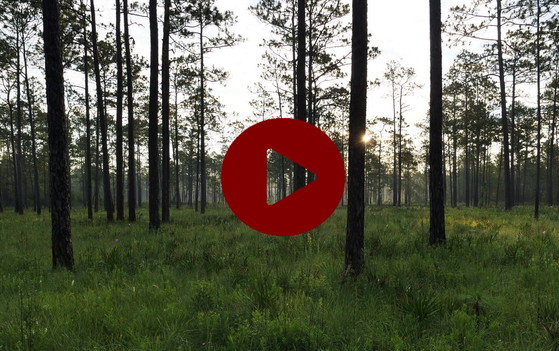 Deep in south Georgia, birds are singing in the break of day at River Creek, the Rolf and Alexandra Kauka Wildlife Management Area.
But the dawn chorus includes an urgent call. An excited squeaking is answered by high-pitched cheeps.
A red-cockaded woodpecker is calling its fledgling. And the young bird is responding, almost plaintively.
These are the sounds of history being made. …
Join DNR on a multimedia journey to restore these rare birds at River Creek.
Top
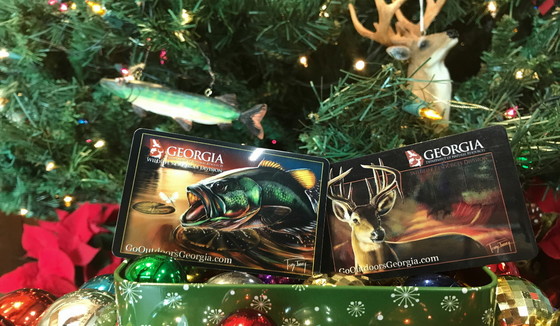 How can you help Georgia's wildlife and wild places? Here are two suggestions that suit the season.
- Purchase or renew a DNR wildlife license plate. They cost only $25 more per year than a peach plate, they make any car or truck look better and almost all of the specialty plate fee is dedicated by law to wildlife work.
- Consider getting a $5 one-day hunting/fishing license. Each sale returns to wildlife management in Georgia up to $45 in federal taxes paid on guns, fishing rods, boat fuel and other products. (And when buying a license, add a hard card to your cart. They make great stocking stuffers.)
Need more ideas? Check out this gift of a blog post.
Top
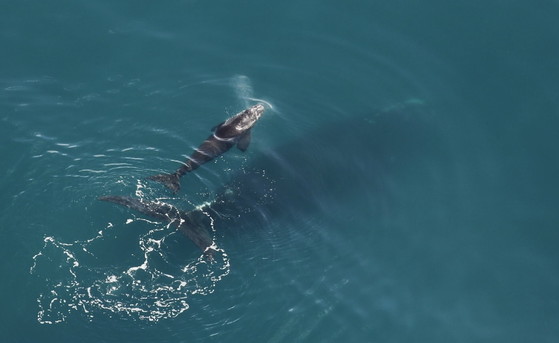 Right whale no. 3560 and her first calf off Sapelo (Clearwater Marine Aquarium/NOAA permit 20556-01)
The calving season for endangered North Atlantic right whales is on.
At least seven adult females have been seen in the Southeast since late November, and the season’s first calf was spotted this week off Georgia’s coast.
A Clearwater Marine Aquarium team flying surveys photographed the newborn and mom about 30 miles east of Sapelo Island. For the mother, cataloged as right whale 3560 and born in 2005, this is her first calf.
North Atlantic right whales are considered one of the world’s most endangered whale species. About 20 calves per year are needed for the population to grow.
WHAT YOU CAN DO
- Give them space: Federal law requires that vessels and aircraft (including drones) stay at least 500 yards away from right whales to reduce the risk of harassment and collisions with boats.
- Report sightings: Call Georgia DNR (800-272-8363), NOAA (877-942-5343) or radio the Coast Guard on marine VHF channel 16.
- Learn more: Explore the New England Aquarium's catalog of right whales and the SAVE Right Whales Act (S. 2453 and H.R. 1568)
Top
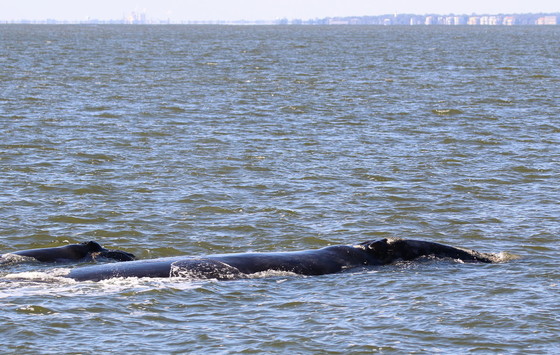 Punctuation with her last calf off Georgia's coast in 2016 (DNR/NOAA permit 15488_0878)
While recent sightings spur hope, scientists who monitor North Atlantic right whales are keenly aware that one well-known whale will not return South this winter.
Female no. 1281, nicknamed Punctuation for a unique pattern of white scars on her head, died last summer in Canada’s Gulf of St. Lawrence. She was hit by a vessel.
Over nearly four decades, Punctuation had been seen at least 250 times along the eastern seaboard. More importantly, she had been prolific, giving birth to eight calves.
Yet even in death, she stands out, revealing the dangers right whales face and the growing fear this species is heading toward extinction.
Clay George, a senior DNR biologist, said that at the rate right whales are dying, they could be “functionally extinct by the end of this century.”
“We’ve got to stop killing them, and fast.”
Read Punctuation’s story and watch video of her and a calf.
Top
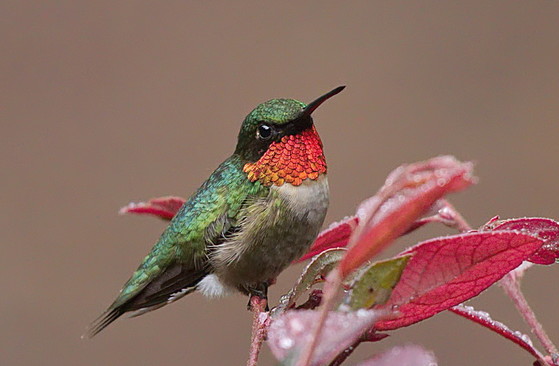 Ruby-throated hummingbird in White County (Mark Whitney/DNR)
By TERRY W. JOHNSON
I strongly believe that if a survey were done to determine which bird is the favorite of most Georgians, the ruby-throated hummingbird would be the clear winner.
While this flying jewel spends only a few short months with us each year, its beauty, feistiness and aerial acrobatics have earned this bird a special place in our hearts.
Yet, while their departure each fall leaves us anxiously awaiting their return in March, we probably give little thought to where ruby-throats spend the winter. Maybe that’s because we assume wherever that is, it’s much like where we’re used to seeing them.
Yet when biologists were finally able to find and describe the habitat occupied by ruby-throated hummingbirds after they leave the U.S. each year, it was quite different from what many of us imagined. …
Read Terry’s column to learn where ruby-throats winter and why.
Terry W. Johnson is a retired DNR program manager and executive director of TERN, the Wildlife Conservation Section’s friends group. Check out past columns, his Backyard Wildlife Connection blog and his book “A Journey of Discovery: Monroe County Outdoors.” (Permission is required to reprint this column.)
Top
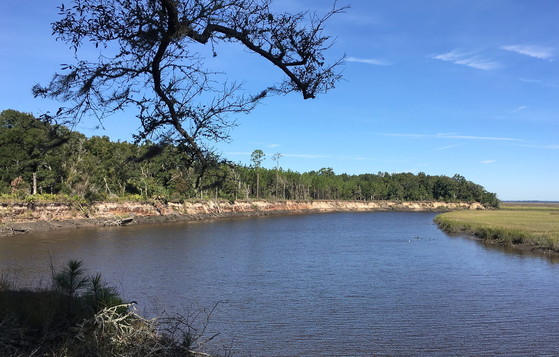 The Ceylon property features acres of rare and undeveloped habitat. (The Conservation Fund)
Nearly 16,000 acres acquired by The Conservation Fund and Open Space Institute in Camden County make up one of the largest undeveloped, unprotected shoreline properties on the southeast Atlantic. The plan is to work with DNR and federal partners to conserve and eventually transfer ownership to DNR. The Satilla River site is home to high-priority habitats and more than 2,000 gopher tortoises.
Following that news was the announcement that Open Space Institute and DNR, with help from partners, had acquired two more important conservation sites in southeast Georgia. One, covering 1,666 acres near Jesup, has the largest known population of the endangered plant hairy rattleweed, while the other adds nearly 270 acres to Moody Forest Wildlife Management Area.
Another conservation success: Almost 13,900 acres along the Savannah River in South Carolina will never be developed. Credit landowners and private and public organizations who teamed up to protect the Groton Plantation, the state's largest conservation easement and home to rare species such as red-cockaded woodpeckers.
Top
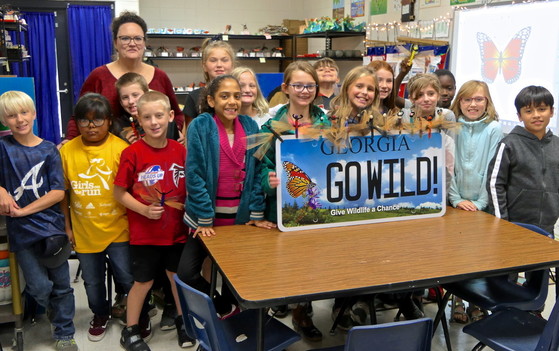 Teacher Stephanie Hodges poses with students and a DNR pollinator plate (Linda May/DNR)
A Bulloch County teacher’s proposal to create a pollinator garden earned her school a $1,000 grant from DNR and friends group The Environmental Resources Network. On hearing she was picked to receive the 2019 Conservation Teacher of the Year grant, Stephanie Hodges of Portal Elementary said her students “are eager to create the garden that will make a real difference for pollinators in our area.”
Wanted: More projects that need a hand helping Georgians enjoy and better understand animals, plants and habitats emphasized in Georgia’s State Wildlife Action Plan. DNR is seeking proposals for its Wildlife Viewing Grants Program, with Jan. 15 set as the deadline to apply for the grants capped at $3,000 each.
Federal legislation to help states protect more than 12,000 species in need of conservation weathered a House Natural Resources Committee “markup” Dec. 5. Next steps for the bipartisan Recovering America’s Wildlife Act (H.R. 3742), which would dedicate $1.3 billion a year for State Wildlife Action Plan priorities without raising taxes, include minor amendments and a hearing before the full House.
Top
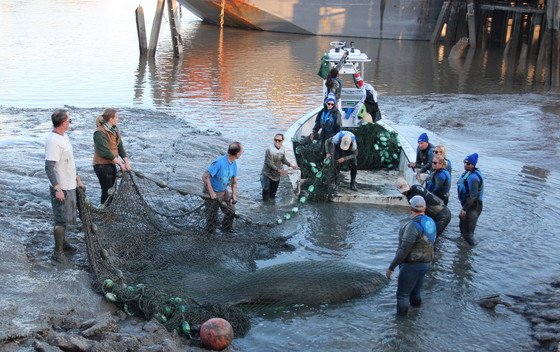 Muddy manatee rescue on the Savannah (Clearwater Marine Aquarium/USFWS permit 770191)
Another cow-calf pair of manatees were rescued recently, this time from Imperial Sugar’s warmwater discharge on the Savannah River. SeaWorld is rehabilitating both manatees for release. A mother rescued earlier from a St. Simons Island golf course tidal pond is also fine in Florida (her calf died of chronic cold stress during transport), as was a manatee freed from a berm along the Savannah. The latter, nicknamed Jno, left Savannah Nov. 3 and made it to Miami’s Biscayne Bay by Nov. 25, covering more than 450 miles in 23 days (continue following Jno).
An amphibian virus with possible links to south Georgia poses a significant threat to amphibian diversity in the U.S. That’s the take of researchers at the universities of Tennessee and Florida who modeled the potential spread of ranavirus RCV-Z2 through wood frog tadpoles. DNR funded a hunt for RCV-Z2 in amphibians in the Alapaha River watershed, near where the virus possibly originated.
The Upper Coosa Conservation Summit held by DNR Wildlife Resources Division and Kennesaw State University staff in late October drew more than 70 people from some 25 organizations. The focus was Coosa Basin conservation, although a smaller group also discussed priorities on the Conasauga River.
The North American Wetlands Conservation Act marked its 30th anniversary last week. Passed in part to support the North American Waterfowl Management Plan, the act created an international agreement and grants to protect wetlands and other habitats – 30 million acres so far – vital to migratory birds.
Top
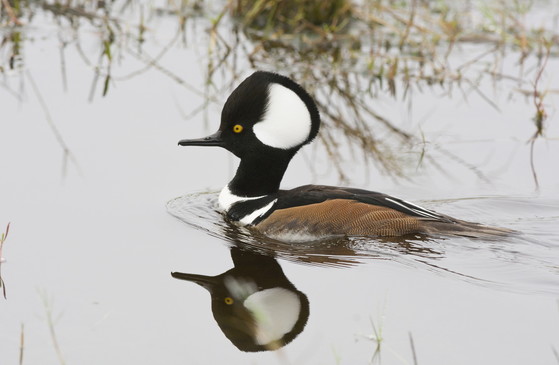 Male hooded merganser (Tom Wilson/Georgia Nature Photographers Association)
Birders in Georgia and nationwide began scouring their “circles” for birds Saturday in the Christmas Bird Count. The annual Audubon Society event, held Dec. 14-Jan. 5 and rated one of the world’s longest-running citizen science projects, involves participants counting species in set circles (find one near you).
Critical habitat proposed for the Suwannee moccasinshell includes some stream stretches in Georgia’s Brooks and Lowndes counties, according to the U.S. Fish and Wildlife Service. Though now rare and federally listed as threatened, the freshwater mussel was once found throughout much of the Suwanee River Basin.
Purpledisk honeycomb-head does not need Endangered Species Act listing, the Fish and Wildlife Service announced this week. This wetland perennial found in pine savanna and flatwood habitats in Georgia and three neighboring states has suitable habitat, thanks to management done at Fort Stewart and other sites.
Invasive species on the coast took a hammering this summer from Student Conservation Association interns led by DNR biologist Eamonn Leonard. The program, coordinated through the Coastal GA Cooperative Invasive Species Management Area, featured three interns tackling invaders from water hyacinth and phragmites, with a focus on helping landowners root out five top-priority species.
Top
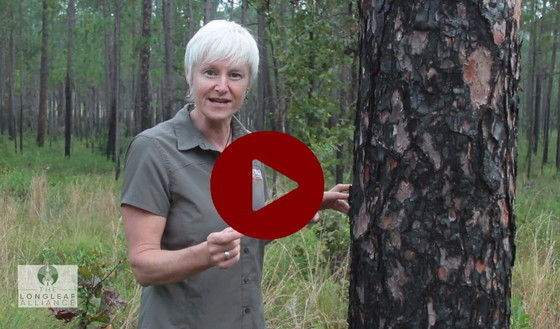 Names in the news: Fire Management Officer Shan Cammack (above), of DNR's Wildlife Conservation Section, is featured in The Longleaf Alliance's new video "Longleaf for the Long Run." The video was produced by Abel Klainbaum and uses as a music track "Moody Forest," a song by Wilma that celebrates the ecology and conservation of Georgia's Moody Forest. Thom Litts has been named fisheries chief for the DNR Wildlife Resources Division. The longtime employee and previously program operations manager for the agency's Fisheries Management Section was appointed after former Chief Matt Thomas retired. The fall issue of the Georgia Department of Transportation’s Milepost magazine profiles DOT teamwork with DNR wildlife biologist Thomas Floyd to make sure roadwork and other transportation projects don’t harm eastern hellbenders. For this year's Georgia-Florida game, Govs. Brian Kemp of Georgia and Ron DeSantis of Florida made a bet in which the loser would go hunting with the other, for feral hogs in Georgia or pythons in Florida. You know how this ends: Dogs won, hogs lost.
UPCOMING
Jan. 31-Feb. 1 – Weekend for Wildlife 2020 (annual DNR fundraiser), The Cloister, Sea Island
March 2-6 – Southeastern Partners in Plant Conservation symposium and workshop, Southeastern Center for Conservation, Atlanta Botanical Garden, Atlanta
March 6-8 – Environmental Education Alliance of Georgia annual conference, Villas by the Sea, Jekyll Island
For more: DNR Wildlife Resources Division events calendar
WHAT YOU MISSED ...
In the previous Georgia Wild:
– How to rescue a manatee
– Invasion of the snakeheads
– Drought impacts on wildlife
– Hellbenders' deadly neighbors
Top
"Conservation groups make major land buy along Georgia coast," The New York Times and others via AP, including ABC News. Plus: GPB (audio), WABE-FM (90.1, Atlanta), The Atlanta Journal-Constitution, Camden County Tribune.
"Rare plant protected," The Atlanta Journal-Constitution. Also: Effingham Herald.
"Teacher of year (DNR grant recipient) takes learning outside," Statesboro Herald
"Answer the call to save bobwhites," The Augusta Chronicle
"USDA to give Georgia $1.5 million to fight wild hogs," WALB-TV (Ch. 10, Albany)
"Manatees rescued in Savannah River," Bluffton Today, and others including WTGS-TV (Ch. 4, Charleston, S.C.)
"Eastern black rails, ESA and tool that supports both," Open Spaces
"Georgia may gain a national park," The Atlanta Journal-Constitution
"The intelligence of plants," The Paris Review
(paywall) "Loggerhead shrike a study in butcher birds," Savannah Morning News
"Georgia seeks projects to allow better views of wildlife," Athens Banner-Herald, and others via AP
"Bill would ban possession, sale of invasive iguanas, tegus in Fla.," Florida Politics
"Why the world needs bloodsucking creatures," Smithsonian.com
"Pelican sightings more common in northwest Georgia," Rome News-Tribune
"500,000+ sea turtles hatched in S.C.," WJCL-TV (Ch. 22, Savannah)
"Follow the herd: Track animals' migratory journeys," The Washington Post
VIDEO AND AUDIO
DNR's Emily Ferrall explains bat culvert surveys, DNR
(audio) "Fall of Torreya and What's Being Done to Save It," In Defense of Plants
Top
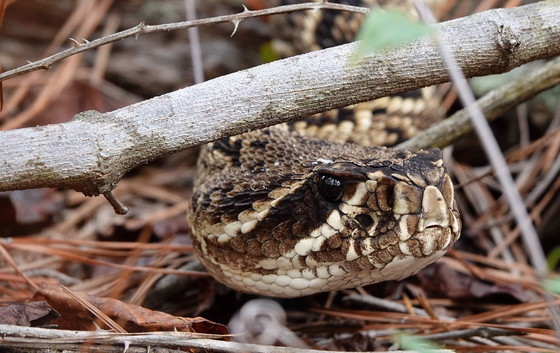 Eastern diamondback rattlesnake (Matt Moore/DNR)
DNR’s Matt Moore not only knows reptiles, he knows how to get great close-ups. Here is a sample from fieldwork this year in south Georgia. (Moore also took the photo of the eastern indigo snake in this issue's masthead.) And if you missed his video of the interaction between an adult and juvenile cottonmouth, turn to the Wildlife Resources Division's YouTube channel.
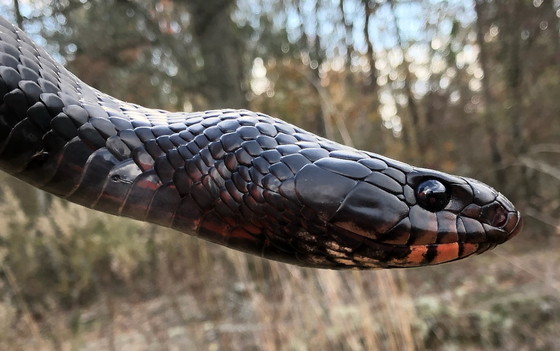 Male eastern indigo snake (Matt Moore/DNR)
.
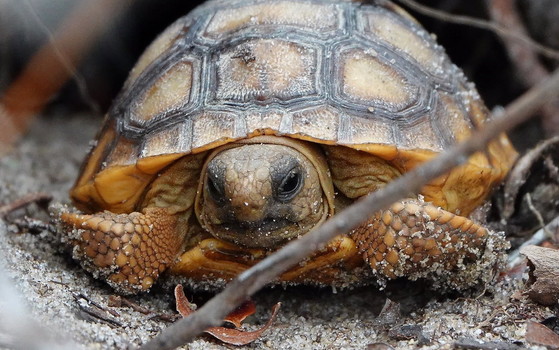 Juvenile gopher tortoise (Matt Moore/DNR)
CREDIT
Masthead: eastern indigo snake (Matt Moore/DNR)
Top
|